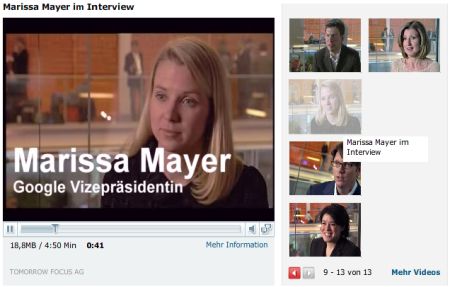von Roland Hachmann | Mai 16, 2007 | Blog, Digital Culture, Marketing Trends
A TechCrunch post on the new Pew Internet & American Life Project study mentions the increasing digital divide amongst the internet use population in the US. One thing I found quite funny was the name for the 8% top internet users. They’re called omnivores, because they consume everything, no questions asked.
8% of people are considered to be “omnivores†which the study describes as being Web 2.0 devotes, highly engaged with video online and digital content; “creative participants in cyberspaceâ€.
That’s me, I guess!
von Roland Hachmann | Mai 15, 2007 | Blog, Digital Culture, Digital Marketing, Digital News
Something for the German readers of this blog. German weekly magazine „Focus“ shows video interviews with celebrities of the digital world. I suppose these videos were made during this years DLD conference.

You can find names like Marissa Mayer, Lars Hinrichs, Arianna Huffington, Caterina Fake, John Naisbitt, Bruce Sterling, etc. Well worth watching, they’re short enough, only a few minutes each.
von Roland Hachmann | Mai 14, 2007 | Blog, Digital Culture, Marketing Trends, Social Media Marketing
So this how people get alienated these days: by having too many digital connections with others. Says this article on Forbes.
Thanks to technology, people have never been more connected–or more alienated
There is a lot of Klischee stuff in that article, but yet some good quotes:
The self that grows up with multitasking and rapid response measures success by calls made, e-mails answered and messages responded to.
We live a contradiction: Insisting that our world is increasingly complex, we nevertheless have created a communications culture that has decreased the time available for us to sit and think, uninterrupted.
One thought, though, takes it a little over the top, I think:
One says, „I don’t have enough time alone with my mind“; another, „I artificially make time to think.“ Such formulations depend on an „I“ separate from the technology, a self that can put the technology aside so as to function apart from its demands. But it’s in conflict with a growing reality of lives lived in the presence of screens, whether on a laptop, palmtop, cell phone or BlackBerry. We are learning to see ourselves as cyborgs, at one with our devices. To put it most starkly: To make more time means turning off our devices, disengaging from the always-on culture. But this is not a simple proposition, since our devices have become more closely coupled to our sense of our bodies and increasingly feel like extensions of our minds.
(found on the „cult of the amateur“ blog.)
von Roland Hachmann | Mai 9, 2007 | Blog, Digital Culture, Social Media Marketing
While other online radio stations close their gates due to new licensing rules, last.fm will now even include videos, writes read/writeweb. They’ll start with smaller independent labels, but will have, allegedly, also partnerships with bigger ones like EMI and Warner. And they are negotiating with Sony and Universal.
Once that is live, you should be able to compile your own video channel, too. In even better quality than anything you can currently (llegally) get on YouTube. read/writeweb calls it the MTV of web 2.0 and I think that defines it quite well.
von Roland Hachmann | Mai 9, 2007 | Blog, Digital Culture
Having first looked at joost a few days ago, I wasn’t very impressed with the contents I could find. But certainly, they are (were?) still in beta. Now you can read everywhere that they are signing new deals with content providers / producers / TV stations.
In Tuesday’s deal with Time Warner Inc.’s Turner Broadcasting System, Joost said it would air episodes of the popular “Aqua Teen Hunger Force†and “Robot Chicken†from Turner’s Adult Swim network, along with “Larry King Live†and other CNN news and interview programs.
Still doesn’t sound too great to me, but then there are apparently other deals, such as:
- Sony Corp. will run episodes of several old TV series including “Charlie’s Angels†and “Starsky & Hutch†on Joost.
- Time Warner’s Sports Illustrated will run photo shoots and programs about its swimsuit issue.
- The National Hockey League will broadcast vintage games and game highlights.
- Hasbro Inc. will run old episodes of “Transformers†and “G.I. Joe.â€
If they continue like this, then they will soon enough have a lot of good quality content. Considering that you can choose what you watch, and the fact that the quality of the streamed (peer-to-peer) videos is very good, this is a real competition to any regular cable TV…
von Roland Hachmann | Mai 8, 2007 | Ad News, Blog, Digital Culture, Digital News, Marketing, Marketing Trends, Mobile Marketing, Social Media Marketing
While I am still unsure about the real value of Twitter in marketing, Rohit Bhargava mentions four ideas of how Twitter can be valueable. I still ain’t convinced completely, but getting there…
Capture the live pulse of an event
This is one of the most popular marketing uses that I have seen for Twitter, where it is used to offer a visual display of conversations happening around an event. More and more interactive events have this, and I suspect other non-Web related events will start to incorporate it as well to offer participants a visual way to track the pulse of an event and determine where to spend time.
Undoubtedly, this could work. The question is: who is the target audience? If it is all those people at the event, who subscribe to one twitter feed about the event, it could be brilliant to let everyone know what is happening elsewhere within the event. If it is for people outside the event, the whole twittersphere of the event will sound like 140-character long gibberish to those not present, I suppose.
Deepen a static experience through live commentary
I saw an interesting story last week about how Fox is going to be using Twitter to promote their new show Drive by having the director provide live updates and directors commentary via Twitter throughout the show. We will definitely be seeing more of this type of marketing in the near future.
This could be nice, but only if the show is live, too. Otherwise, we’ll be reading tweets about stuff that we know nothing about until we see it a few months later on TV.
Facilitate collaborative watching
When it comes to watching video content online or on television, Twitter can allow you to watch something „alongside“ anyone anywhere by sharing your impressions and reading impressions from others as a program unfolds. This is a powerful new method of sharing feedback and ideas
This won’t work, if we truly believe in the end of programmed television. If people are not watching things at the same time, because everyone can watch „on demand“, then how can you share your thoughts with other viewers via twitter? Unless there is a „twitter group“ for that particular movie or series – and I just underestimate the scale of randomness: the fact that for some shows, there will always be somebody, at any given time, watching the same show as myself…
Add a new dimension to promotions
Scavenger hunts, user generated content campaigns, and other reality based marketing promotions are growing popularity as ways to encourage interaction from customers. Twitter can offer a way of encouraging dialogue between promotion participants and adding an „instant message style“ dimension to a promotion without the privacy and contact acceptance barriers normally associated with using IM for marketing.
This, I think, could be a fantastic use for twitter. A connection of customers in Twitter groups during promotions, enabling „swarm intelligence“, as we call it here in Germany, would be a brilliant setup for all sorts of ideas for promos, alternate reality games, real life social games or gatherings, etc.
So, in general, I start to like the idea of using Twitter for marketing, having been sceptical a few weeks / months ago. But I do think, that we still need a lot of refinement to make sure it’s not just a gimmick, but does actually contribute value to campaigns.


 Wo ich sonst so bin...
Wo ich sonst so bin...